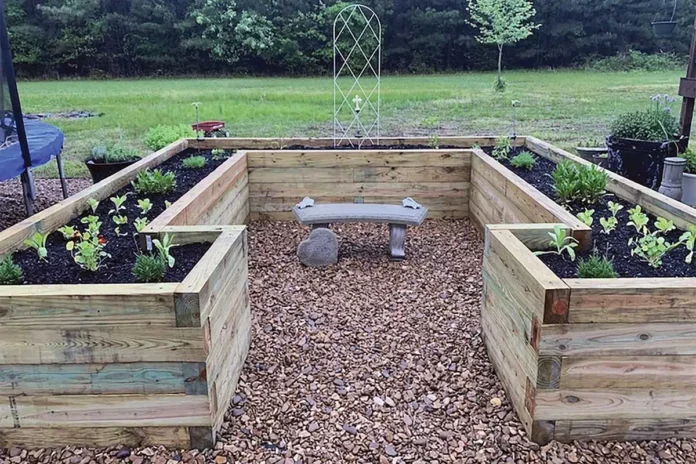Creating a raised garden bed doesn’t need to be an expensive project. With some planning and creativity, you can build a functional and beautiful garden space on a budget. Raised garden beds offer numerous benefits, such as better soil control, improved drainage, and easier maintenance. These beds are ideal for small spaces and make gardening accessible to people with limited mobility. You can transform any outdoor space into a flourishing garden using inexpensive or free materials like recycled wood, cinder blocks, or straw bales. Whether you’re a seasoned gardener or just starting, building a raised garden bed on a budget is a rewarding way to grow your plants and vegetables.
With this guide, you’ll learn how to build a raised garden bed cheaply, from choosing the right location to planting your favorite flowers or vegetables. It’s time to get started!
Step 1: Choose The Right Location
Raised garden beds are successful when they are placed in the right location. It is important to choose an area that will provide the best conditions for your plants to grow. You should start by choosing a spot with plenty of sunlight. Most plants require six to eight hours of direct sunlight daily. Avoid placing your garden bed in a shaded area unless you’re growing plants that require less light, like leafy greens.
Accessibility
Next, think about accessibility. Make sure the spot is easy to reach for watering, planting, and harvesting. The last thing you want is to walk around obstacles or struggle to access your garden bed. It should also be within reach of a water source to make watering easier.
Good Drainage
Lastly, ensure good drainage in your chosen location. If the ground is prone to pooling water, consider raising the bed slightly or adding gravel at the bottom to promote proper water flow. Well-drained soil helps prevent root rot and ensures plants get the appropriate moisture.
Step 2: Gather Materials
When building a raised garden bed on a budget, your materials play a significant role. Fortunately, many inexpensive or even free materials are available for this purpose. Here’s a list of affordable options:
- Recycled Wood: Old pallets, scrap wood from construction sites, or even repurposed fence panels can be used to construct the frame of your garden bed. Just make sure to avoid treated wood, as it may contain harmful chemicals that can leach into the soil.
- Cinder Blocks or Bricks: Cinder blocks are an inexpensive option, and they can be easily stacked to form the sides of your garden bed. They also have the added benefit of allowing water to drain through the gaps, preventing waterlogging.
- Straw Bales: Straw bales can be used as temporary garden bed walls. They are biodegradable and will break down over time, enriching the soil as they do.
- Logs or Branches: If you can access fallen logs or branches in your yard, they can serve as a rustic, natural border for your raised garden bed.
- Cardboard or Newspaper: These materials are great for weed suppression. Lay them down at the bottom of the bed to block weeds from growing through the soil.
Tools Needed:
- Saw (for cutting wood or pallets to size)
- Hammer and Nails (for securing the frame)
- Measuring Tape (to ensure accurate dimensions)
- Gardening Gloves (for safety)
Step 3: Build The Frame
As soon as you’ve gathered your materials, begin building your raised garden bed frame. The wood or material should be measured and cut to the desired length. If you’re using cinder blocks, you can stack them directly on the ground, but if you’re using wood or logs, you’ll need to create corners and secure them with nails or screws. For extra durability, consider adding a second layer of wood or cinder blocks, especially if you want a taller bed.
The height should be at least 12 inches for a typical raised bed, but you can make it taller if you have deeper-rooted plants. The width should be no more than 4 feet, so you can easily reach the center from both sides without stepping into the bed and compacting the soil.
Step 4: Fill With Soil
After your frame is built, it’s time to fill your raised bed with soil. One of the most cost-effective ways to fill a garden bed is by mixing topsoil with compost or manure. You can purchase these materials in bulk at garden centers or find them for free from local farms or your compost pile. If you’re looking for even more savings, use yard waste or kitchen scraps to make your compost.
For the perfect soil mixture, aim for a blend of:
- 60% topsoil
- 30% compost
- 10% organic matter (such as shredded leaves or grass clippings)
This mixture will give your plants the nutrients they need while offering good drainage. For even better results, layer cardboard or newspaper at the bottom of the bed before adding soil to suppress weeds.
Step 5: Plant And Mulch
It’s time to start planting your raised garden bed once the soil has been filled in! Choose plants based on your growing zone, available sunlight, and personal preferences. If you’re working with limited space or want to save money, consider growing seeds instead of purchasing mature plants. Many vegetables, herbs, and flowers can be started from seeds, which are often much cheaper.
After planting, apply a layer of mulch to help retain moisture and suppress weeds. Organic mulches, such as straw, wood chips, or shredded leaves, are inexpensive and will gradually break down to add nutrients to the soil. Mulch also helps regulate the temperature of the soil, keeping it cooler in hot weather and warmer during colder months.
Maintenance Tips (Optional)
Maintenance goes a long way to keeping your raised garden bed in top condition. Here are some simple tips to extend the life of your garden bed and ensure healthy plant growth:
- Watering: Water your garden profoundly and evenly, especially during dry spells. A soaker hose or drip irrigation system can make this task easier and more efficient.
- Fertilizing: Refresh the soil yearly with compost or organic fertilizer to replenish nutrients. You can also add a layer of mulch to protect the soil from erosion.
- Weeding: Even though you’ve used cardboard or newspaper to block weeds, they may still appear. Check your garden bed regularly and pull weeds by hand to prevent them from taking over.
- Repairs: If the frame of your raised garden bed begins to show signs of wear, make minor repairs using extra wood or other materials you have on hand.
Conclusion
Building a raised garden bed doesn’t have to be expensive. You can create a thriving garden without breaking the bank by using recycled materials and making smart choices about location, size, and soil. Whether growing vegetables, herbs, or flowers, a raised garden bed is a practical, efficient way to boost your gardening success. Happy gardening!
Frequently Asked Questions
Q: What is the cheapest material for building a raised garden bed?
The most affordable materials for building a raised garden bed include recycled wood, such as pallets or old fence panels, cinder blocks, and straw bales. These materials are often readily available for little to no cost.
Q: Can I use untreated wood for my raised garden bed?
Yes, untreated wood is an excellent option for raised garden beds because it is free of harmful chemicals that could leach into the soil. Standard untreated wood options include cedar, pine, and fir, but even scrap wood can work well.
Q: Can I make a raised garden bed without spending any money?
It’s possible to build a raised garden bed with little to no cost by using free materials like recycled wood, cinder blocks, or even straw bales. You can also use yard waste and kitchen scraps to make your own compost for the soil.
Q: Do I need to treat the wood for my raised garden bed?
While some gardeners opt to treat wood with non-toxic wood preservatives, untreated wood is often recommended for raised beds to avoid introducing chemicals into the soil. Using untreated wood will eventually break down, but you can replace it over time.
Q: How do I water a raised garden bed efficiently?
A soaker hose or drip irrigation system is an affordable and efficient way to water a raised garden bed. These systems deliver water directly to the soil, reducing water waste and ensuring your plants get the moisture they need.
Q: Can I build a raised garden bed on concrete or asphalt?
You can build a raised garden bed on concrete or asphalt, but ensuring proper drainage is important. You may need to add a layer of gravel or rocks at the bottom of the bed to encourage water flow and prevent water from pooling.
Read Also: Outdoor Table Lamp For Your Space



